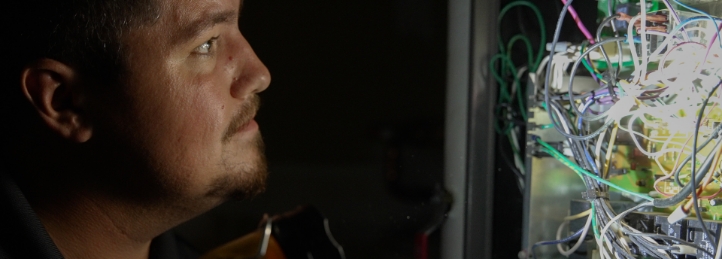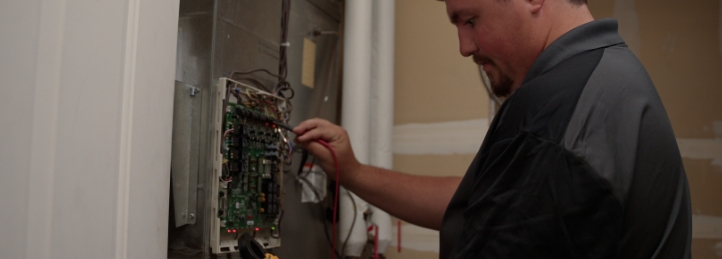Heating Systems

In Montana, the unique climate means residents often rely on heating systems for more than 275 days a year. The most common types in Montana homes include forced air, boiler, and ductless systems powered by gas, electricity, or propane. Ambient’s team is trained to service, repair, and install both forced air and boiler systems.
- NATE and EPA-certified technicians
- Coleman Premier Dealer Award recipients
- 24/7 emergency service for all brands and models
We are the trusted experts for heating installation, maintenance, repairs, and more in Bozeman, MT.
Book an appointment with Ambient Air Solutions today—Simplifying Heating & Cooling!
Forced Air Systems
A forced air system is a type of HVAC setup that distributes air through ducts using a blower or fan, which moves heated or cooled air from a furnace or air conditioner into different parts of a building. The airflow warms or cools rooms by adjusting the air temperature around them.
Key components of forced air systems include:
- Furnace or AC unit: Heats or cools the air.
- Ductwork: Moves air to different rooms.
- Blower/Fan: Pushes air through the system.
- Thermostat: Manages temperature settings.
Forced air systems are popular for their efficiency in distributing air evenly and their dual heating and cooling capabilities.
Boiler Systems
Boiler systems generate heat by heating water or steam, which then circulates through pipes to radiators, baseboard heaters, or radiant floor systems. Boilers provide warmth by heating objects in a room, resulting in radiant heat rather than directly heating the air.
Essential components of a boiler system include:
- Boiler unit: Heats water or produces steam.
- Pipes: Distribute water or steam.
- Radiators: Release heat into the space.
While boilers offer consistent warmth, they don’t provide cooling, so a secondary system may be needed for air conditioning.

Ductless Systems
Ductless systems, or mini-splits, offer both heating and cooling without traditional ductwork. These systems consist of an outdoor compressor/condenser and one or more indoor air-handling units mounted on walls, connected by refrigerant lines that allow for heat transfer.
Key benefits of ductless systems include:
- Zoned Heating/Cooling: Each indoor unit controls a specific area’s temperature.
- Energy Efficiency: No ducts mean minimal energy loss.
- Flexibility: Suitable for homes without existing ducts or for room additions.
Ductless systems are valued for their flexibility, energy efficiency, and ability to control temperatures in individual rooms.
Heating Maintenance
Just like your vehicle, heating systems require routine maintenance to stay efficient and reliable. Regular upkeep helps prevent inconvenient breakdowns, especially during holidays like Thanksgiving or Christmas.
Reasons for Annual Maintenance:
- Efficiency: Keeps systems running smoothly, lowering energy costs.
- Longevity: Tackles minor issues before they turn into major repairs.
- Safety: Ensures components like burners are operating safely to prevent hazards.
- Consistent Heating: Maintains reliable warmth during colder months.
Heating Repair
It often seems like heating systems choose the worst times to break down. If you notice unusual sounds, uneven heating, or higher energy bills, it might be time to call us. Ambient Air Solutions provides 24/7 emergency service with local representatives answering the phones, offering dependability and a great customer experience.
When to Call an HVAC Company:
- Odd noises (grinding, banging, squealing)
- Inconsistent heating (cold spots in some rooms)
- Frequent cycling (system turns on and off often)
- Strange odors (musty or burning smells)
- Rising energy bills without increased usage
Replacement of Heating System
Choosing a new heating system is a significant decision. Your system is essential for comfort and safety, so selecting the right one is crucial. Ambient Air Solutions is here to simplify the process with options that fit your needs.
Efficiency of Furnaces
Furnace efficiency is measured as AFUE (Annual Fuel Utilization Efficiency), with higher percentages indicating more fuel used for heating.
- 98% AFUE – Modulating Furnace: Adjusts heat output based on needs, offering consistent temperatures and energy savings.
- 96% AFUE – Two-Stage Furnace: Operates at two levels, reducing energy consumption by running at a lower setting for mild heating needs.
- 95% AFUE – Single-Stage Furnace: Runs at full power, suitable for smaller homes or areas with mild climates.
Efficiency of Boilers
Boilers, with AFUE ratings that range between 80–90%, convert fuel to heat. High-efficiency models, such as condensing boilers, capture additional heat from exhaust gases, making them more eco-friendly.
Efficiency of Ductless Systems
Ductless mini-splits offer high efficiency, with SEER ratings up to 30 for cooling and HSPF ratings between 8–12 for heating. Their zoned capabilities and avoidance of ductwork reduce energy loss, making them a top choice for energy-conscious homeowners.
Efficiency of Heat Pumps
Heat pumps move heat between indoors and outdoors, providing heating and cooling by transferring rather than generating heat. Their energy-efficient operation makes them ideal for year-round comfort, even in colder climates.

The Importance of Furnace Maintenance During Montana Winters
Winter in Montana brings harsh temperatures, snow, and ice that can last well over half the year. With such prolonged periods of cold weather, a well-functioning furnace becomes more than just a luxury; it’s essential for comfort and safety. Regular maintenance and timely repairs are vital to ensure your furnace operates reliably and efficiently throughout the season. Here’s why keeping your furnace in peak condition is crucial during Montana’s winter months:
Ensures Consistent, Reliable Heating
During Montana’s frigid winters, even a minor furnace issue can leave you shivering. Without proper maintenance, small problems can go unnoticed and lead to uneven heating, with cold spots forming in various areas of your home. Regular checkups ensure that all components of your furnace are functioning optimally, providing consistent warmth and preventing uncomfortable cold zones.
Improves Energy Efficiency and Reduces Costs
A well-maintained furnace operates at peak efficiency, which directly affects your energy bills. When dirt, dust, or minor malfunctions interfere with your furnace’s performance, it must work harder to maintain your desired temperature, consuming more energy. Routine maintenance like changing air filters, cleaning burners, and inspecting parts can reduce wear and tear and lower your monthly heating costs, a significant benefit when your furnace runs nearly all winter long.
Prevents Unexpected Breakdowns
Furnace breakdowns often occur when temperatures are at their lowest, as extreme cold puts additional stress on heating systems. A breakdown not only disrupts your comfort but can also lead to emergency repair costs and potentially hazardous conditions. Regular maintenance can identify and address potential issues before they lead to a complete failure, reducing the risk of inconvenient breakdowns during the coldest parts of winter.
Extends Furnace Lifespan
Furnaces are a significant investment, and with Montana’s long winters, homeowners expect them to last many years. Neglecting maintenance shortens the lifespan of your furnace, as unresolved issues compound over time and lead to more significant damage. By investing in routine maintenance, you’re effectively prolonging the life of your furnace, deferring the need for a costly replacement and getting more value out of your investment.
Ensures Safe Operation
Safety is a top priority with any heating system, particularly with fuel-burning furnaces that produce carbon monoxide (CO). A cracked heat exchanger or other malfunctioning component can cause CO to leak into your home, which poses a serious health risk. Routine furnace inspections ensure that critical components like heat exchangers, burners, and vents are intact and functioning safely. A well-maintained furnace provides warmth without the worry of safety hazards for you and your family.
Enhances Indoor Air Quality
A furnace with a clean filter and well-maintained ductwork doesn’t just keep your home warm; it also helps maintain better indoor air quality. Dust, dirt, and allergens can accumulate in a neglected furnace, recirculating through your home and causing respiratory irritation or allergy flare-ups. By keeping your furnace clean and changing filters regularly, you’re also ensuring cleaner, healthier air for everyone in your household.
Avoids the Winter Rush for Repairs
Winter is peak season for furnace repairs, and heating technicians are often booked solid during cold snaps. By scheduling regular maintenance in the fall, you can avoid the rush and secure service appointments more easily. This preparation ensures that any issues are resolved before winter hits, reducing the chance of needing emergency service when demand is highest and wait times are longer.
Essential Maintenance Tasks for Montana Furnaces
For maximum efficiency and reliability, here are a few critical maintenance tasks every Montana homeowner should address each year:
- Replace or Clean the Air Filter: Dirty filters reduce airflow, forcing your furnace to work harder and lowering efficiency. Replacing filters every 1–3 months during winter keeps your system operating smoothly.
- Clean Burners and Flame Sensor: Dirt buildup on burners can prevent your furnace from igniting properly, while a dirty flame sensor can lead to frequent shutdowns. Cleaning these parts ensures smooth operation.
- Inspect the Heat Exchanger: Cracks or damage in the heat exchanger can lead to CO leaks. Regular inspections are essential for both safety and efficiency.
- Lubricate Moving Parts: Your furnace has various moving parts that benefit from periodic lubrication. This reduces friction, conserves energy, and prolongs component life.
- Check the Thermostat: A properly calibrated thermostat ensures accurate temperature settings, reducing unnecessary furnace cycling and helping maintain consistent warmth.
When Should You Call for Furnace Repairs?
Some furnace issues can only be handled by a professional. If you notice any of the following signs, it’s best to call your local HVAC technician promptly:
- Strange noises: Grinding, banging, or rattling sounds can indicate a mechanical issue or loose components.
- Cold air blowing: This can signal a problem with the blower or an issue in the ductwork.
- Increased energy bills: If your bills are unusually high, it might indicate that your furnace is struggling and consuming more energy.
- Short cycling: When the furnace turns on and off frequently, it could be due to overheating, poor airflow, or a thermostat problem.
- Yellow pilot light: A yellow flame could indicate improper gas combustion, which is a safety risk and should be addressed immediately.
Don’t Wait—Schedule Your Winter Furnace Service Today
In Montana’s unpredictable winters, a well-maintained furnace provides not only warmth but also peace of mind. Ambient Air Solutions offers comprehensive furnace services, from routine maintenance to emergency repairs. Let our experienced team help you ensure that your furnace is in top shape to handle the long winter ahead.
